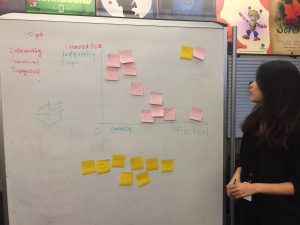
Hi everyone! We’re Team Tada currently at the SV campus, working with EA to create an internal data visualization tool for developers.
In the first week, we met with our client to find out his requirements and vision for the tool. To obtain further insights on the needs of our users, we also met with a community manager for the Sims franchise and an analyst working on the Battlefront and Titanfall titles. Based on their information, our team brainstormed several ideas with the criteria of innovation and practicality in mind.

Jiayang in our brainstorming session
Based on our brainstorming and what we learned from the people we met, we decided on three main ideas to pitch to our client in the second week:
- Social Hub. Categorizes and analyzes user-generated content from multiple social channels for a game.
- Cross-title Dashboard. Shows basic metrics for all titles across a timeline, including offline and online events.
- 3D data visualization. Visualize data using web VR or use AR/projection to view activity happening across a game map. (We had to put a crazy one in there)
After our mini pitch presentation, we decided to move forward with the social hub idea, augmented with the timeline functionality in from our cross-title dashboard idea. 3D visualization of data was too extreme, but the client appreciated our efforts on being creative.
Lessons learned
Given a project topic that has a wide definition with multiple areas of exploration, it is important to understand the users’ needs. For this, we need to have as many meetings as we can with people from different departments. Having the vision to target those requirements will narrow our scope and increase the effectiveness of our solution. We have to understand their needs and how our tool can help the development team address those exactly.
For the next week, we’ll focus on various branding materials and build a prototype for the product.